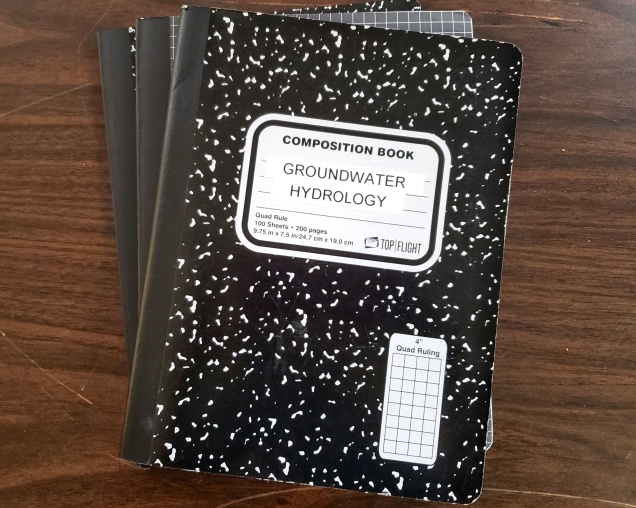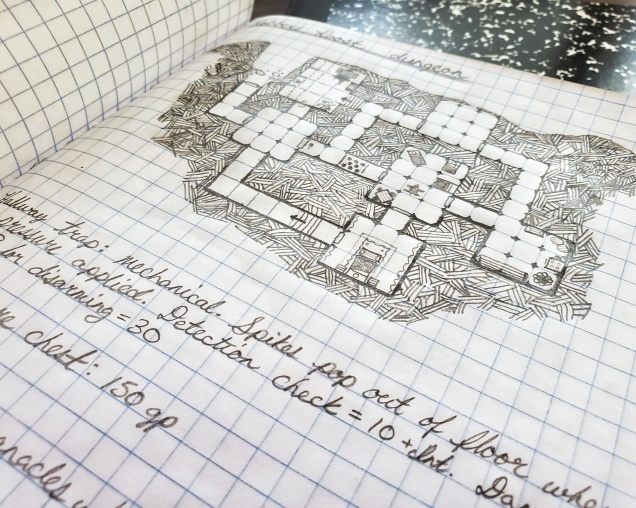We all love our good paper, right? You know I’m a sucker for a nice creamy tint. Tight, subtle ruling. A little tooth. Substantial weight. Resistance to bleed-through and feathering of ink on the rare occasion I want to use a pen. I feel you, paper snobs.

But sometimes — and lately, it seems, more often than not — I just need something that works. I don’t need to shop around for “the one”. I don’t need something special. I certainly don’t need to drop $20. I just need some paper that I can write on, bound up securely in a manageable shape and size, with a cover that can take some abuse (and won’t make me feel bad about destroying).
In other words, sometimes I need a good ol’ Composition Notebook.
You know what I’m talking about. Whether it was English class in high school or Chem Lab in college, these are the dirt-cheap notebooks with flimsy paper bound sloppily in a two-toned, black and white, faux-marble cardstock cover that teachers and professors demanded we use. The one where it doesn’t matter what brand you buy, because they’re all totally identical. Is this jogging your memory?
When I was a little kid, I used to envy the big kids who carried that iconic notebook. By the time I was an undergrad, I had learned to hate them. But now as a grad student who has a career and multiple hobbies, I love them.

I didn’t fall hard and fast for the Composition Notebook. It just grew on me over time. I think it all started when I decided to start doing my personal monthly budget on paper. I just needed somewhere to keep a ledger for each month, plus some info on who I owe money and who owes me, any irregular expenses/income coming up, and other things like savings goals and investment ideas. This is the sort of stuff that is irrelevant in a few months, and the notebook would be replaced at the end of the year. Odds are the thing would end up being used to start a campfire, or given to my kids to rip any blank pages out and scribble on. It definitely didn’t need to be expensive.
I rarely have interest in showing anyone that I’m completely broke as shit, so I certainly wasn’t in the market for an elegant display in which to write my budget. The ideal notebook did, however, need to be compact enough to fit in my man-purse while still being large enough to create a legible layout. It also needed some sort of a sturdy cover — rigid, yet one that I wouldn’t cry about if it got roughed up while being hauled all over hell’s half acre — to keep the pages inside from being wadded up as I went about my daily business.
I knew one notebook that checked all of those boxes.
Before long, I began to see the Composition Notebook as a masterpiece of utilitarianism that was effective for any sort of project that demanded ~150 pages of handwriting permanently bound together in a durable and portable volume.
I stopped writing my university lecture and reading notes on expensive engineering paper, let alone stashing them in that bulky three-ring binder. I could simply start a new composition notebook with each course; easily haul it between home, campus, and work; and catalog it at the end of the year using my label maker for later reference during my oral defense.

When I recently decided to take up Dungeons and Dragons and homebrew my own campaign to play with my kids, guess where I started stashing all of my content? A grid-ruled composition notebook is the perfect place for maps, character blocks, lists of encounters, and simply jotting down story ideas. Once the game gets underway, I’m sure a college-ruled companion will be perfect for jotting down game notes.
I’m starting to see all of the other possibilities. Recipes? Journals? Writing a novel? The functions are endless.
Icing on the cake: it’s “back to school” time around these parts, which means the ruled Composition books can be rustled up for 33 cents each. You know I’m loadin’ up!
Don’t get me wrong — it’s not a solution to everything. I’ll still be doing my hand-written course assignments on engineering paper. For my work notes, I’ve taken a fancy to the Docket Gold narrow-ruled, three-ring pads. I’m pretty committed to the Traveler’s Notebook for my personal journal/diary thing, my daily planner, and my scratch notes. There are obviously nicer, bigger, better-writing, prettier, or longer-lasting options out there and I don’t fault anyone for opting for one of those.
There are some things in the world that you have to tip your hat to, however, due to their simplicity, durability, economy, and the fact that they’ll do the trick 80% of the time. The simple pocket knife. The AK-47. The Subaru station wagon.
Tack the Composition Notebook onto the list. And whatever you do, don’t turn your nose up at it — you might just end up falling in love with it.

I’d started using these more frequently, as I felt a lot less guilty about pulling out a new one for a new project or passing fancy without feeling guilty if I abandoned them at a 15 – 30% full. But anymore I can’t seem to find any with stiff covers, they all seem to be rather flimsy and floppy.
LikeLiked by 1 person
Agreed! I keep a stack of these handy for various projects. I am currently writing a book and all of my research notes, outlines,etc. go into a composition book. Tip: If the spine starts to peel away, black duck tape fixes it right up.
LikeLiked by 1 person
I like the disposable nature of composition notebooks as well. I don’t feel guilty getting rid of a partially used one.
The quality of paper in composition notebooks varies greatly, even from the same brand. I tend to buy multiples when I find a batch with less transparent paper.
LikeLike
Check out the Exceed brand at Walmart. Very nice paper, comparatively speaking!
LikeLike
As a “general rule” (meaning it’s mostly correct but not perfect) comp books made in Egypt, India, Vietnam, or Brazil are more likely to be fountain pen friendly. I’ve never found a comp book made in the US that worked well with fp. Books made in China are more likely than the US, less likely than those listed above.
LikeLike
I love composition books, they definitely formed a huge part of my childhood stationery experience! Sadly, most of them aren’t very fountain pen friendly so I can’t use them as often as I’d like. Their utilitarian nature are enticing. Sometimes you need something simple to get work done.
LikeLike